11 Species of Hawks In Kansas [A Complete List]
Did you know that there are more than 200 different species of hawks available across the world? And in the United States, you can spot approximately 25 different kinds. But can you spot them all in Kansas?
You can spot a total of 11 species of hawks in Kansas. The most common one is the Red-tailed hawk, while the state’s least common or accidental species is the Gray Hawk.
Now, the real question is, what do each of the hawks present in Kansas look like? And most importantly, in which season or months can you expect to find them flying the skies of Kansas? Well, if you want to get all these answers, you will need to continue reading.
1. Red-tailed Hawk (Buteo jamaicensis)
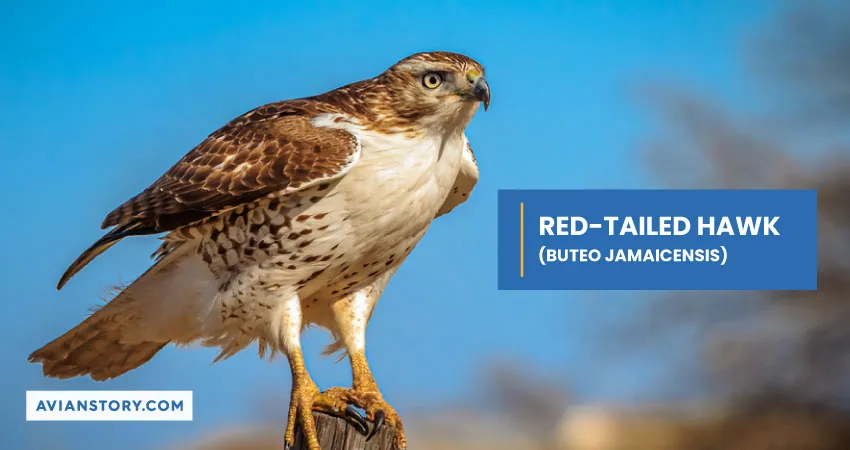
As mentioned earlier, the Red-tailed hawk is the most common species of hawk in Kansas. They appear in the state in both summer and winter, making them appear the highest in the checklist of Kansas. However, the number of these hawks increases in winter. So, you have a better chance of sighting them in that season.
Attributes
The hawk lives up to its name. They feature a wide, short, and red tail. And this distinctive feature is highly noticeable when they are flying high in the skies. You will also notice their rounded, large, and broad wings during the flight.
These haws are more on the brown side when it comes to coloration. But the brown feathers are primarily found in the backside of the birds. Their bodies’ underside is pale in color.
Diet
Red-tailed hawks have a very diverse diet. They eat pretty much anything, from small mammals to birds to reptiles. Basically, the diet depends on the location they are staying at and the season.
Nesting Preference and Eggs
These birds of prey typically build a nest in the crows of high trees. They like to have a commanding view of the area, which is why they will pick tall points of the trees. Their breeding season starts in March and runs through May. And during the breeding season, expect to find 1 to 5 eggs inside their nests.
2. Northern Harrier (Circus cyaneus)
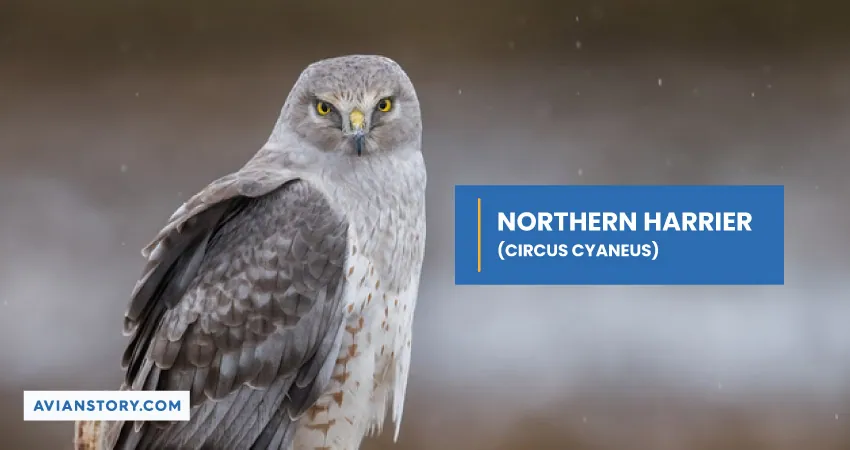
The Northern Harrier is the second most common hawk in Kansas. They are mostly present in the state during summer. So keep your eyes peeled during this season if you want to spot one of them.
Attributes
Northern Harriers have relatively slender bodies. But their wings are long and broad. Their bodies are also comparatively large in size. For perspective, you can expect them to be between a goose and a crow.
But the most noticeable feature of these raptors comes to light when they are flying. They fly in a V-shape, which makes them easy to spot in the skies.
In terms of coloration, the females have brown feathers throughout their bodies. They also have white underparts and gray upper parts. You will also notice a white rump patch on them.
Males, on the other hand, have a gray upper part and whitish feathers on the underparts. They have a dark trailing edge on their wings and black wingtips. On the tail, you will notice black banding on the males.
Diet
The Northern Harriers mostly live on small birds and small mammals. But that does not mean that they do not hunt large-sized prey. You can find them munching on large ducks and rabbits.
Nesting Preference and Eggs
These raptors are known to nest on the ground. However, do not expect to find them out in the open. Instead, they choose locations that are well-concealed. Often, their nests will be in tall clumps of vegetation or near low shrubs. The breeding season is from April to July or May to September, when females can lay 3 to 6 eggs.
3. Cooper’s Hawk (Accipiter Cooperii)

You can find Cooper’s hawks in Kansas throughout the year. However, they are most common in winter. They appear in the state’s skies during the summer, but the sighting record is relatively less for summer than winter.
Attributes
Adult Cooper’s hawks have a blue-gray feather on the upper portion of their bodies. There are warn reddish bars on the underparts. And on the tail, you will notice thick dark bands. Juvelines, on the other hand, have a brown upper part and crisp streaking on the upper chest. That makes them get a hooded look.
Diet
The diet of these birds of prey mostly consists of medium-sized birds. That includes birds that are in the size range of jays, robins, and flickers. But they are known to sometimes rely on smaller and larger birds. Other than birds, they can eat a lot of different small mammals, which include tree squirrels, chipmunks, bats, and mice.
Nesting Preference and Eggs
Cooper’s hawks prefer mixed-deciduous, deciduous, and evergreen forests for nesting. You can also find some of their nests in urban and suburban areas. The breeding season starts in early March. And females can lay 2 to 6 eggs during this season.
4. Red-shouldered Hawk (Buteo lineatus)
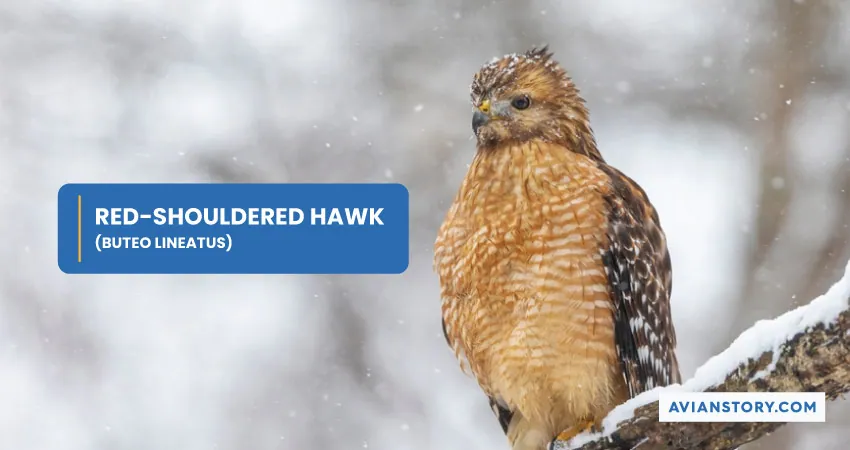
Another year-round resident of the state of Kansas is the Red-shouldered hawk. But you will mostly find them on the eastern border of the state. And your chances of spotting them in this state are higher in the winter season.
Attributes
As the name suggests, the Red-shouldered hawks have red feathers on their shoulder region. They also have distinctive markings, reddish barring on the chest, and white and dark checkered wings. And they have a strong banding on their tails. When it comes to size, these raptors are in between a swan and a crow.
Diet
You can consider the Red-shouldered hawks to be a generalist. They rely on different types of prey, which includes mammals, birds, reptile, and amphibians. But you should know that their diet depends on the season. And mainly, they will rely on mammals.
Nesting Preference and Eggs
The preferred spots to nest for Red-shouldered hawks are in mixed deciduous-coniferous or deciduous forests. You will typically find their homes in the crook of the main trunk of deciduous trees. In the breeding season, which is in between April and July, you can find 2 to 5 eggs in their nests.
5. Sharp-shinned Hawk (Accipiter striatus)
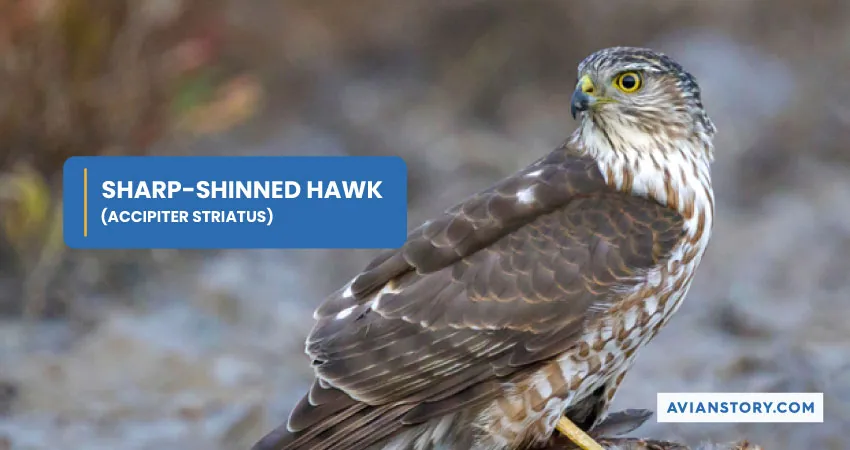
The Sharp-shinned hawks are present all across North America, which includes Kansas. However, they are mostly spotted during the winter, especially between the months of September and May.
Attributes
One of the first things that make the Sharp-shinned hawks stand out is their body size. They are comparatively smaller than the other hawks. They also feature rounded and short wings. The same thing is applicable to their heads, which are small in size. But in contrast, they have a relatively long tail.
Adults have slaty blue-gray feathers on the upper portion. And on the chest, they have red-orange bars. On the other hand, the younglings tend to have brown-colored feathers with coarse vertical streaking on their white below.
Nesting Preference and Eggs
The sharpies tend to pick small groves of dense evergreens. They like spots with clearings nearby. The breeding season of the Sharp-shinned hawks is from late March and June. Females can lay anywhere from 4 to 5 eggs during the breeding season.
6. Swainson’s Hawk (Buteo swainsoni)

In Kansas, you will find the Swainson’s hawks in the warmer months, mostly in summer. But, generally, September and April are the best months to spot them.
Attributes
The adult Swainson’s hawks have dark brown plumage, pale bellies, white patches on their throats, and brown feathers on their breast. You can easily recognize them when they are perched. That is when they spread their wings longer than their tails.
Diet
The Swainson’s hawks mostly rely on rabbits, rodents, and reptiles. But when they are not breeding, they can switch up their diet and feed mainly on insects, which include dragonflies and grasshoppers.
Nesting Preference and Eggs
For nest placement, Swainson’s hawks choose the highest point of solitary trees. But you can also find their nests in the small grove of trees that are along a running stream.
The breeding season of the Swainson’s hawks starts in the middle of May and runs through late July. In this season, females can lay 1 to 5 eggs.
7. Rough-legged Hawk (Buteo lagopus)
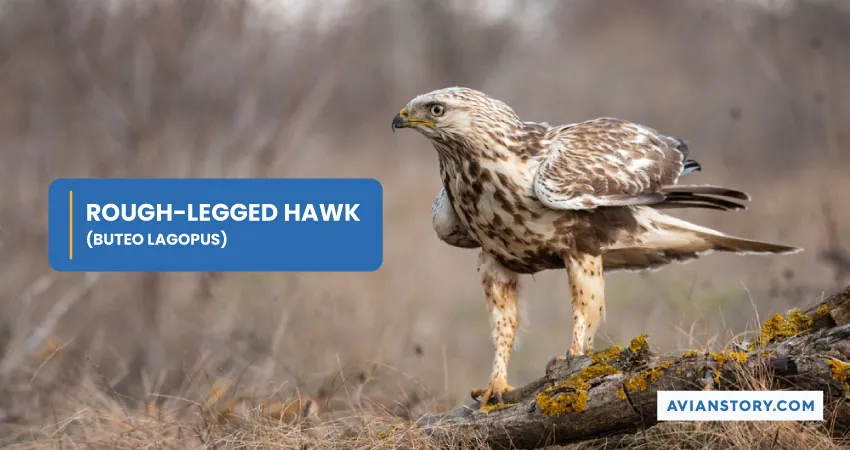
The Rough-legged hawks that you will find in Kansas are among the non-breeding group. Here, non-breeding birds are those that are not currently breeding. However, there are only sighting reports during the winter, especially between the months of October and April.
Attributes
One of the standout features of the rough-legged hawks is that they have reasonably broad-sized wings. Compared to the wings of other raptors, their wins are narrow and long. Also, the tail of these birds is longer than most of the other buteos. And their wingtips are generally swept back from their wrist.
Nesting Preference and Eggs
The rough-legged hawks will pick outcroppings in the treeless tundra, low-lying boreal forest, alpine regions, and uplands. They can also nest on cliffs. The breeding season of these birds is during March and April, in which females can lay anywhere from 1 to 7 eggs.
8. Broad-winged Hawk (Buteo platypterus)
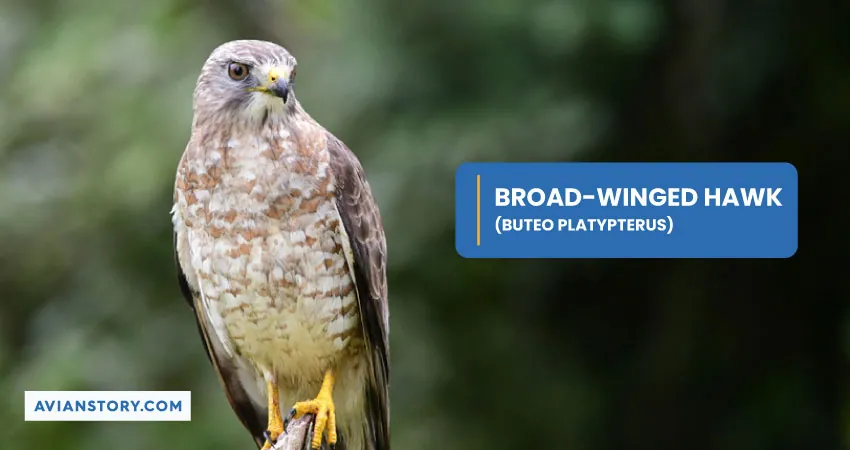
The eastern border of Kansas contains a small breeding range of Broad-winged hawks. And throughout the other parts of the state, you will find a breeding-only range of these hawks, which is the birds that are currently breeding.
Also, in Kansas, you have a high chance of spotting them during the summer, which is from April to October.
Attributes
Broad-winged hawks have barred underparts, reddish-brown heads, and black and white bands on their broad tails. You can consider their bodies to be small but stocky. And on adults, you will notice horizontal chestnut stripes or cinnamon stripes on the chest.
Diet
The Broad-winged hawks primarily feed on reptiles, amphibians, mammals, and birds. But you can sometimes find them eating fish, crayfish, earthworms, and centipedes.
Nesting Preference and Eggs
These raptors will generally choose lower parts of large-sized trees for nesting. Their nests are typically 25 to 40 feet above the ground. And between April and August, their breeding season, you will find 1 to 5 eggs in their nests.
9. Ferruginous Hawk (Buteo regalis)
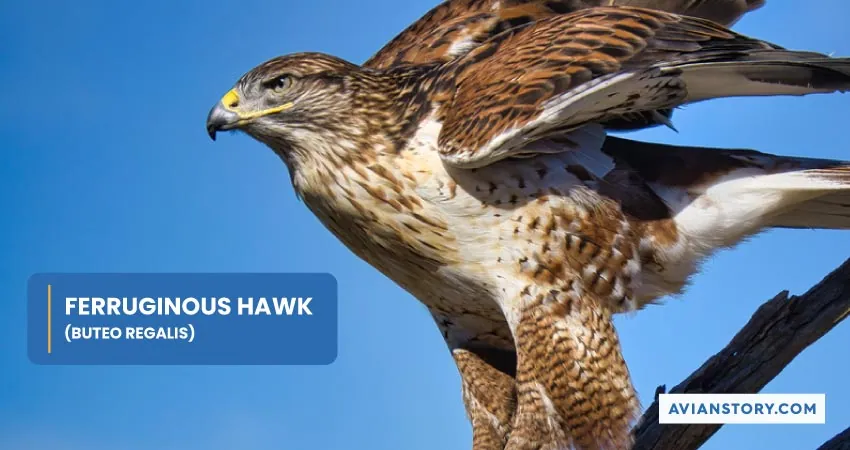
The Ferruginous hawks are considered to be rare hawks in Kansas. You will only be able to see them in the western part of the state during winter.
Attributes
Ferruginous hawks are the largest buteo in the whole of North America. But that is not the only feature that makes them noticeable. Ferruginous hawks have dark, short, and hooked beaks. They also have yellow and long gaps. In terms of coloration, adults have brown feathers above and white and rusty streaks on the underside.
Diet
These raptors mostly feed on small prey that is readily available. That includes ground squirrels, young jackrabbits, pocket gophers, cottontails, kangaroo rats, and mice.
Nesting Preference and Eggs
The Ferruginous hawks prefer lone trees, utility structures, cliffs, outcrops, shrubs, haystacks, or boulders for nesting. The nesting height varies. Some can be more than 65 feet high, while others are on the ground. And during the breeding season, females tend to lay mostly 2 to 4 eggs. Sometimes, it can be 6 or higher.
10. Northern Goshawk (Accipiter gentilis)
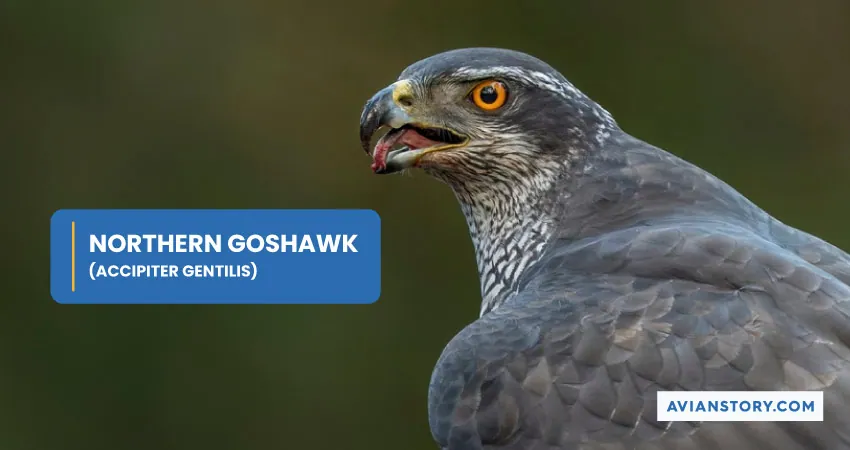
The Northern Goshawks that are available in Kansas are non-breeding. And they are one of the rare hawks of the state. But you have a better chance of spotting them during the winter.
Attributes
Northern Goshawks’ most prominent features are dark cap, blue or slate gray back, and striking white lines on their eyes. The undersides of these hawks have white streaking with gray and black feathers. Adults have striking red-colored eyes, which is something that you can not miss.
Nesting Preference and Eggs
These birds of prey usually build large-sized nests with sticks. And usually, they will pick the trunk of a tree or a spot on a broken trunk. If you come across their nests between early April and mid-June, you will find 2 to 4 eggs inside them.
11. Gray Hawk (Buteo plagiatus)
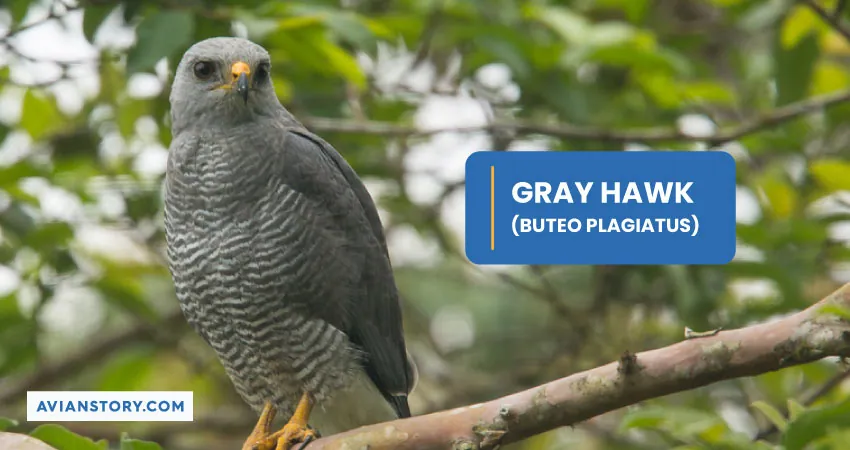
The Gray hawks are accidental species of Kansas. There has been only one sighting report in the state, which dates all the back to 1990. So, there is no concrete info regarding in which season you will be able to spot them.
Attributes
As the name suggests, the Gray hawks have pale gray feathers on their bodies. Their chests are finely barred and have prominent black and white banding on their tails. Their under-tail coverts have white feathers, and they feature dark wingtips.
That said, juveniles tend to have dark brown feathers on their backside. They also tend to have heavy brown streaking and spotting on their underparts.
Diet
The Gray hawks mostly rely on lizards and are known to prey on different kinds of species of lizards. However, you can definitely find them hunting birds, mice, small rabbits, large insects, and ground squirrels.
Nesting Preference and Eggs
These raptors will choose outer branches on the other upper portion of trees for nesting. They rarely pick a spot near the main trunk. And when it comes to type, they prefer riparian trees. Females usually lay 2-3 eggs in early May, which is when their breeding season starts.
| Name | Length | Weight | Wingspan | Commonly Found In | Behavior | Fun Fact |
| Red-tailed Hawk | 17.7 to 25.6 inches | 1.52 to 3.22 pounds | 44.9 to 52.4 inches | Open areas such as swamps and agricultural lands. | Territorial | Have an eyesight that is 8 times better than humans. |
| Northern Harrier | 16.14 to 19.68 inches | 0.69 to 1.69 pounds | 41 to 46 inches | Prairies, marshes, and open fields | Primarily solitary | These birds have a remarkable sense of hearing. |
| Cooper’s Hawk | 14.6 to 17.7 inches | 0.49 to 1.5 pounds | 24.4 to 35.4 inches | Woodlands, dense forests, and near backyard feeders. | Territorial and aggressive. | Cooper’s hawks are known to mate only once in their entire lifespan. |
| Red-shouldered Hawk | 16.9 to 24.0 inches | 1.07 to 1.71 pounds | 37.0 to 43.7 inches | Forests where large clearings are present and in open canopies | Solitary and very territorial | The Red-Shouldered hawks have a peculiar courtship ritual. They often fly together and roll on their backs occasionally. |
| Sharp-shinned Hawk | 9.4 to 13.4 inches | 0.19 to 0.48 pounds | 16.9 to 22.1 inches | Can be found in high montane forests and lowland habitats | Mostly solitary but become territorial when breeding | The hawk gets its name from the flatted and thin shanks or “shins.” |
| Swainson’s Hawk | 18.9 to 22.1 inches | 1.53 to 3.01 pounds | 46 to 54 inches | Scattered groves of trees and in prairie regions | Highly territorial during the breeding season | These birds migrate in swirling flocks. |
| Rough-legged Hawk | 18.5 to 20.5 inches | 1.58 to 3.09 pounds | 52.0 to 54.3 inches | Around nestles of tundra and cliffs of low-lying boreal forests | Territorial | These birds like to live alone and are not social. |
| Broad-winged Hawk | 13.4 to 17.3 inches | 0.58 to 1.24 pounds | 31.9 to 39.4 inches | Edges of water and woods | Territorial and Solitary when they are not migrating | They often reuse the nest of other animals. |
| Ferruginous Hawk | 20 to 25 inches | 2 to 5 pounds | 52 to 56 inches | Old prairies, sage bushes, and open areas | Solitary | These birds get their name from the Latin word “Ferrum,” which stands for iron. |
| Northern Goshawk | 20.9 to 25.2 inches | 1.40 to 3.01 pounds | 40.5 to 46.1 inches | In large forests, usually out of populated areas | Highly territorial | The bird gets its name from the Old English word “goose hawk.” |
| Gray Hawk | 18 to 24 inches | 0.86 to 1.04 pounds | Around 35 inches | Cottonwood forests and willow strands forests. | Solitary | The species was once called Mexican Goshawk because it has an accipiter-like range and appearance. |
Final Words
To recapitulate, you can spot a total of 11 different species of hawks in Kansas. But you have a higher chance of spotting the Red-tailed hawk than the others. It is the most common species in the state. On the other hand, you will have a tough time spotting the Gray hawk in the state as it is accidental in Kansas.
Hawks Found in Nearby States of Kansas:
Resources:
- https://gpnc.org/wp-content/uploads/sites/32/2017/12/KSRaptorsv3-1.pdf
- https://animaldiversity.org/accounts/Asturina_nitida/
- http://pubs.aina.ucalgary.ca/arctic/Arctic49-3-306.pdf
- https://gf.nd.gov/wildlife/id/raptors/swainsons-hawk
- http://www.biokids.umich.edu/critters/Accipiter_striatus/
- https://www.chesapeakebay.net/discover/field-guide/entry/northern-harrier
- https://portal.ct.gov/DEEP/Wildlife/Fact-Sheets/Northern-Harrier
- https://kids.nationalgeographic.com/animals/birds/facts/red-tailed-hawk
Feature Image Credits: Harry Collins Photography, Shutterstock

